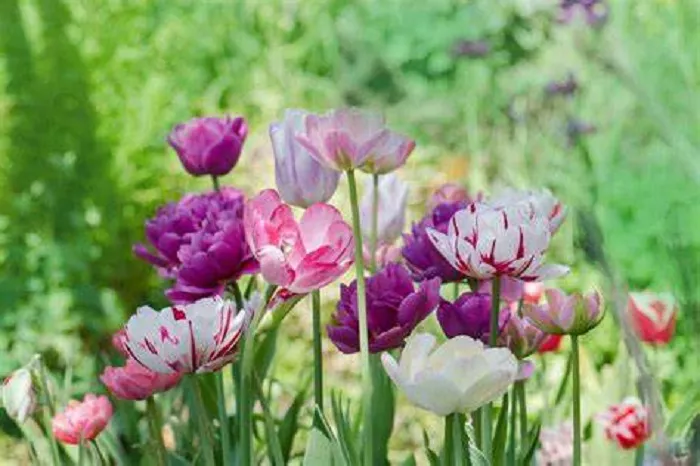Tulips are one of the most beloved flowers in the garden. Their vibrant colors and elegant shapes make them a standout in any landscape. But when do these beautiful flowers bloom? The answer might surprise you. Tulips typically bloom in spring, but the exact month can vary depending on several factors. In this article, we will explore the blooming timeline of tulips and how you can ensure they put on their best show in your garden.
Understanding the Tulip Blooming Season
Tulips are spring-blooming bulbs, which means they need a period of cold dormancy to trigger their growth cycle. This cold period is essential for the bulbs to develop properly. In most regions, tulips start to bloom in late March or early April. However, the exact timing can be influenced by the climate, the specific variety of tulip, and the growing conditions in your garden.
Climate and Temperature
The climate of your region plays a crucial role in determining when tulips will bloom. In areas with mild winters, tulips may start to emerge from the ground as early as late February or early March. The soil temperature is a key factor. Tulips need the soil to warm up slightly after the winter freeze. When the soil temperature reaches around 50°F to 60°F, the bulbs begin to send up shoots. In colder climates, this process may be delayed until mid-April or even early May. It’s important to note that tulips can tolerate some frost, but extreme cold or late frosts can damage the buds and delay blooming.
What Month Do Tulips Bloom?
Not all tulips bloom at the same time. There are hundreds of tulip varieties, each with its own unique characteristics and blooming schedule. Tulips are generally classified into early, mid-season, and late-blooming varieties. Early-blooming tulips, such as the Single Early and Double Early types, usually start to bloom in late March or early April. These varieties are perfect for adding a splash of color to your garden right after the winter thaw. Mid-season tulips, like the Triumph and Darwin Hybrids, typically bloom in mid-April to early May. They are known for their robust stems and large, showy flowers. Late-blooming tulips, including the Single Late and Parrot tulips, make their appearance in late April to early May. These varieties often have more intricate and exotic-looking blooms, adding a touch of drama to your garden.
Planting Time and Care
The timing of when you plant your tulip bulbs also affects when they will bloom. It’s best to plant tulip bulbs in the fall, usually between September and November, depending on your climate. This gives the bulbs enough time to establish their root systems before the winter freeze. When planting, choose a well-draining location with plenty of sunlight. Tulips thrive in full sun and require at least six hours of direct sunlight per day. Plant the bulbs with the pointed end facing up, about 5 to 8 inches deep, depending on the size of the bulb. After planting, water the bulbs thoroughly to help settle the soil. During the growing season, it’s important to provide consistent moisture, especially when the buds are forming. Avoid overwatering, as this can lead to bulb rot.
Extending the Tulip Blooming Season
If you want to enjoy tulips for a longer period, you can use a technique called “layering.” This involves planting bulbs at different depths in the same hole. For example, you can plant larger bulbs deeper and smaller bulbs closer to the surface. This way, the tulips will bloom at slightly different times, creating a continuous display of color. Another option is to plant a mix of early, mid-season, and late-blooming varieties. By doing so, you can have tulips blooming from late March through early May.
Factors That Can Affect Blooming
Several factors can impact the blooming of tulips. One common issue is overcrowding. If tulip bulbs are planted too close together, they may compete for nutrients and space, resulting in smaller blooms or even no blooms at all. It’s important to space the bulbs properly when planting. Another factor is poor soil quality. Tulips prefer well-draining, fertile soil. If your soil is heavy clay or lacks nutrients, you may need to amend it with organic matter such as compost or well-rotted manure. Pests and diseases can also affect tulip blooms. Aphids, for example, can damage the buds and leaves. Regularly inspect your plants for signs of pests and treat them promptly if necessary. Diseases like tulip fire can cause deformed blooms and stunted growth. To prevent diseases, avoid planting bulbs that show signs of rot or damage and ensure good air circulation around your plants.
Tips for Growing Healthy Tulips
To ensure your tulips bloom beautifully, follow these tips. First, choose high-quality bulbs from a reputable supplier. Healthy bulbs are firm and free of blemishes. Second, prepare your soil properly before planting. Remove any weeds and rocks and loosen the soil to a depth of at least 12 inches. Third, fertilize your tulips in the spring when the shoots start to emerge. Use a balanced fertilizer or one specifically formulated for bulbs. Finally, after the blooms fade, allow the foliage to die back naturally. The leaves continue to photosynthesize and provide energy to the bulb for next year’s growth. Cutting the foliage too early can weaken the bulb and reduce future blooms.
Conclusion
Tulips are a wonderful addition to any garden, with their stunning colors and graceful forms. While they typically bloom in spring, the exact month can vary based on your climate, the tulip variety, and how you care for them. By understanding the factors that influence blooming and following proper planting and care techniques, you can enjoy a beautiful display of tulips in your garden. Whether you choose early, mid-season, or late-blooming varieties, or a combination of them all, tulips are sure to brighten your spring days and bring joy to your gardening experience.


